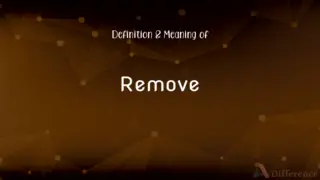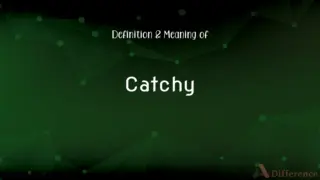Fossils vs. Artifacts — What's the Difference?
By Tayyaba Rehman — Published on November 17, 2023
Fossils are preserved remains of ancient organisms, while Artifacts are man-made objects from past cultures. Both offer insights into history but from different perspectives.

Difference Between Fossils and Artifacts
Table of Contents
ADVERTISEMENT
Key Differences
Fossils are remnants or traces of ancient living organisms that have been preserved over millennia, typically within rock formations. These remains can include bones, shells, or even the subtle imprints of creatures. Fossils serve as a testament to the diverse life forms that existed in prehistoric times and help scientists understand evolutionary processes.
In contrast, Artifacts are man-made objects or tools that have been crafted by past human civilizations. These items can range from pottery and weapons to jewelry and artwork. Unlike Fossils, which are naturally occurring, Artifacts are products of human ingenuity, reflecting the cultural, technological, and social aspects of their originating societies.
While Fossils provide information about ancient ecosystems, biodiversity, and the progression of life on Earth, Artifacts shine a light on human history. They tell stories of daily life, rituals, wars, trades, and the artistic sensibilities of people from bygone eras.
One interesting overlap between Fossils and Artifacts occurs in the realm of ancient human remains. While a bone from an early hominid might be classified as a fossil, a tool or piece of jewelry found alongside it would be considered an artifact. Thus, in archaeological digs, it's common for these two categories to intertwine, providing a holistic view of the past.
In essence, while both Fossils and Artifacts serve as vital historical records, their nature and the information they convey vary considerably. Fossils delineate the biological timeline, while Artifacts chronicle the cultural and technological advancements of human civilizations.
ADVERTISEMENT
Comparison Chart
Origin
Naturally occurring remains
Man-made objects
Represents
Ancient organisms
Past human cultures
Primary Material
Bones, imprints, plant remains
Pottery, metals, stone, etc.
Information Conveyed
Evolution, ancient ecosystems
Human history, culture, technology
Preservation Method
Natural processes (e.g., sedimentation)
Often due to burial or environmental conditions
Compare with Definitions
Fossils
Preserved remains of ancient organisms.
The discovery of dinosaur Fossils fascinates both scientists and the general public.
Artifacts
Tangible evidence of historical human societies.
Museum displays often feature Artifacts from various epochs.
Fossils
Natural imprints or traces of prehistoric life.
Leaf Fossils provide insight into ancient plant species.
Artifacts
Man-made objects from historical or ancient cultures.
Archaeologists unearthed Artifacts from a lost civilization.
Fossils
Mineralized or otherwise preserved remnants from a bygone era.
Amber can sometimes contain Fossils of insects from millions of years ago.
Artifacts
Items reflecting past human activities and technologies.
Stone tools are among the earliest Artifacts of human innovation.
Fossils
A testament to Earth's diverse past life forms.
Studying Fossils helps us understand the history of life on our planet.
Artifacts
Products of human craftsmanship and ingenuity.
Ancient pottery Artifacts offer clues about culinary practices.
Fossils
Key tools in understanding evolutionary processes.
Certain Fossils bridge the gap between aquatic and terrestrial species.
Artifacts
Objects that narrate cultural, social, or artistic tales of the past.
Artifacts from the Renaissance period showcase the era's artistic brilliance.
Fossils
A remnant or trace of an organism of a past geologic age, such as a skeleton or leaf imprint, embedded and preserved in the earth's crust.
Artifacts
An object produced or shaped by human craft, especially a tool, weapon, or ornament of archaeological or historical interest.
Fossils
One that is outdated or antiquated
He was viewed as a fossil after decades in the same job.
Artifacts
Something viewed as a product of human conception or agency rather than an inherent element
"Morality is an artifact of human culture, devised to help us negotiate social relations" (Michael Pollan).
Fossils
A word or morpheme that is used only in certain restricted contexts, as kempt in unkempt, but is otherwise obsolete.
Artifacts
A phenomenon or feature not originally present or expected and caused by an interfering external agent, action, or process, as an unwanted feature in a microscopic specimen after fixation, in a digitally reproduced image, or in a digital audio recording.
Fossils
An archaic syntactic rule or pattern used only in idioms, as so be it.
Artifacts
An inaccurate observation, effect, or result, especially one resulting from the technology used in scientific investigation or from experimental error
The apparent pattern in the data was an artifact of the collection method.
Fossils
Characteristic of or having the nature of a fossil.
Artifacts
Plural of artifact
Fossils
Being or similar to a fossil.
Fossils
Belonging to the past; antiquated.
Fossils
Plural of fossil
Common Curiosities
How are Fossils formed?
Fossils typically form when organisms are buried quickly by sediment and then undergo mineralization over time.
Can Fossils be found everywhere?
While Fossils can be found in many places, certain regions with specific geological conditions are more fossil-rich.
How are Artifacts different from Fossils?
Artifacts are man-made objects from past cultures, while Fossils are naturally occurring ancient remains.
What materials commonly make up Artifacts?
Artifacts can be made of stone, pottery, metal, bone, and other materials used by past civilizations.
What are Fossils?
Fossils are preserved remains or traces of ancient organisms.
Can plants become Fossils?
Yes, plants can leave Fossils, often in the form of imprints or preserved organic material.
Are all old objects considered Artifacts?
Not necessarily; Artifacts specifically pertain to items made or used by humans and hold historical or archaeological significance.
How do scientists date Fossils?
Scientists often use radiometric dating methods, among other techniques, to determine the age of Fossils.
Why are Artifacts important?
Artifacts provide valuable insights into the behaviors, technologies, and cultures of past human societies.
Are contemporary objects ever labeled as Artifacts?
While "Artifact" typically refers to ancient items, in some contexts, more recent culturally significant objects might be termed "contemporary Artifacts."
Share Your Discovery

Previous Comparison
Chondroblasts vs. Chondrocytes
Next Comparison
Intensive Properties vs. Extensive PropertiesAuthor Spotlight
Written by
Tayyaba RehmanTayyaba Rehman is a distinguished writer, currently serving as a primary contributor to askdifference.com. As a researcher in semantics and etymology, Tayyaba's passion for the complexity of languages and their distinctions has found a perfect home on the platform. Tayyaba delves into the intricacies of language, distinguishing between commonly confused words and phrases, thereby providing clarity for readers worldwide.













































